Zara: Retail Theory and Practice in the UK Fashion Industry
VerifiedAdded on 2021/02/20
|11
|3138
|120
Report
AI Summary
This report offers a detailed analysis of Zara's retail operations within the UK fashion industry. It begins with an introduction to retail and the company, followed by an examination of the changes within the UK fashion retail market using a PESTLE analysis, considering political, economic, social, technological, legal, and environmental factors. The report then delves into the microenvironment through a SWOT analysis, identifying Zara's strengths, weaknesses, opportunities, and threats. Subsequently, it explores strategic tactics based on retail theory, including environmental and cyclical theories, and provides recommendations for the company. The report concludes with a summary of the findings and includes references and an appendix. The report emphasizes Zara's position as a major player in the fashion retail sector, the impact of external factors, and the need for strategic adaptation to maintain a competitive edge. This report is contributed by a student and available on Desklib, a platform that provides AI-powered study tools for students.
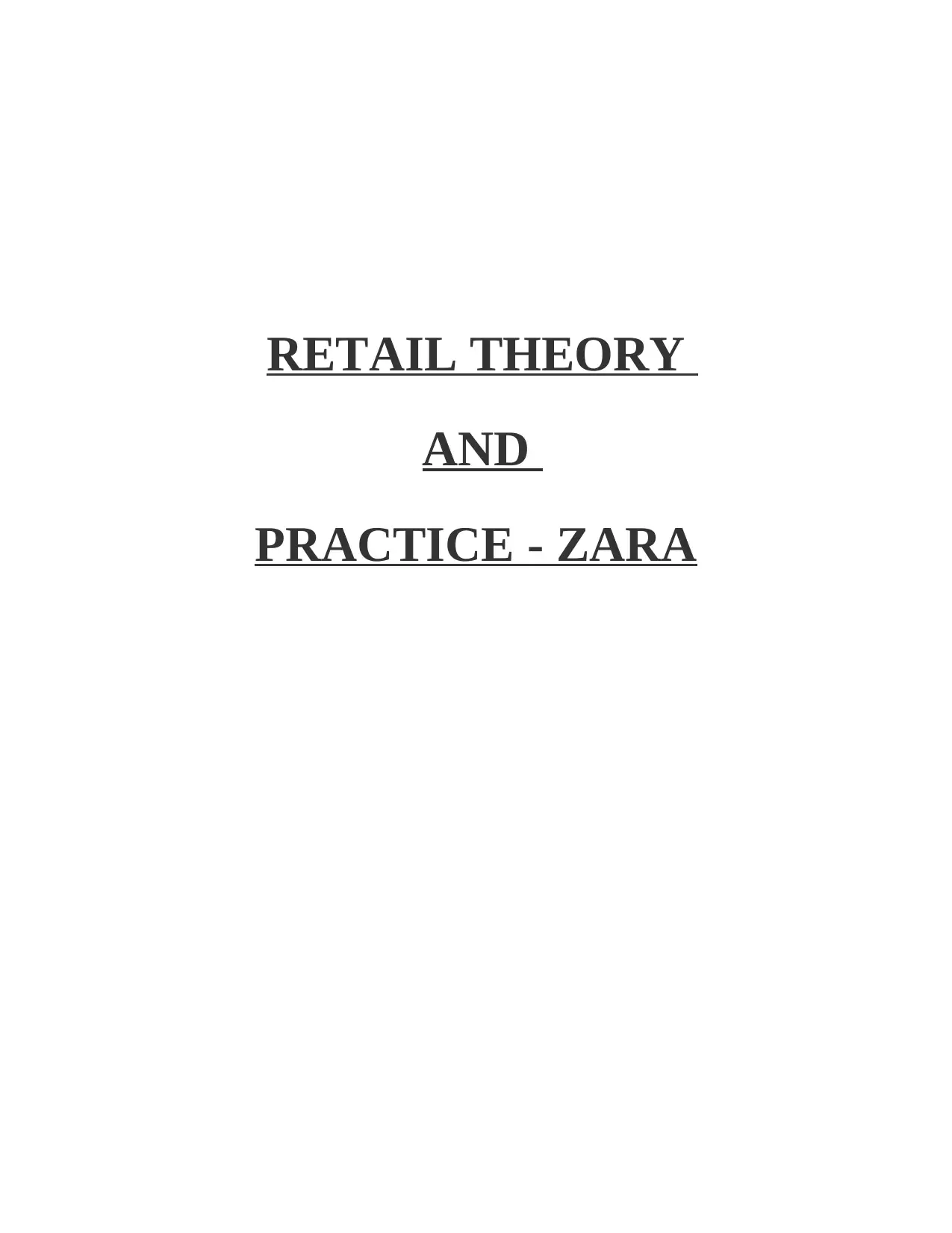
RETAIL THEORY
AND
PRACTICE - ZARA
AND
PRACTICE - ZARA
Paraphrase This Document
Need a fresh take? Get an instant paraphrase of this document with our AI Paraphraser
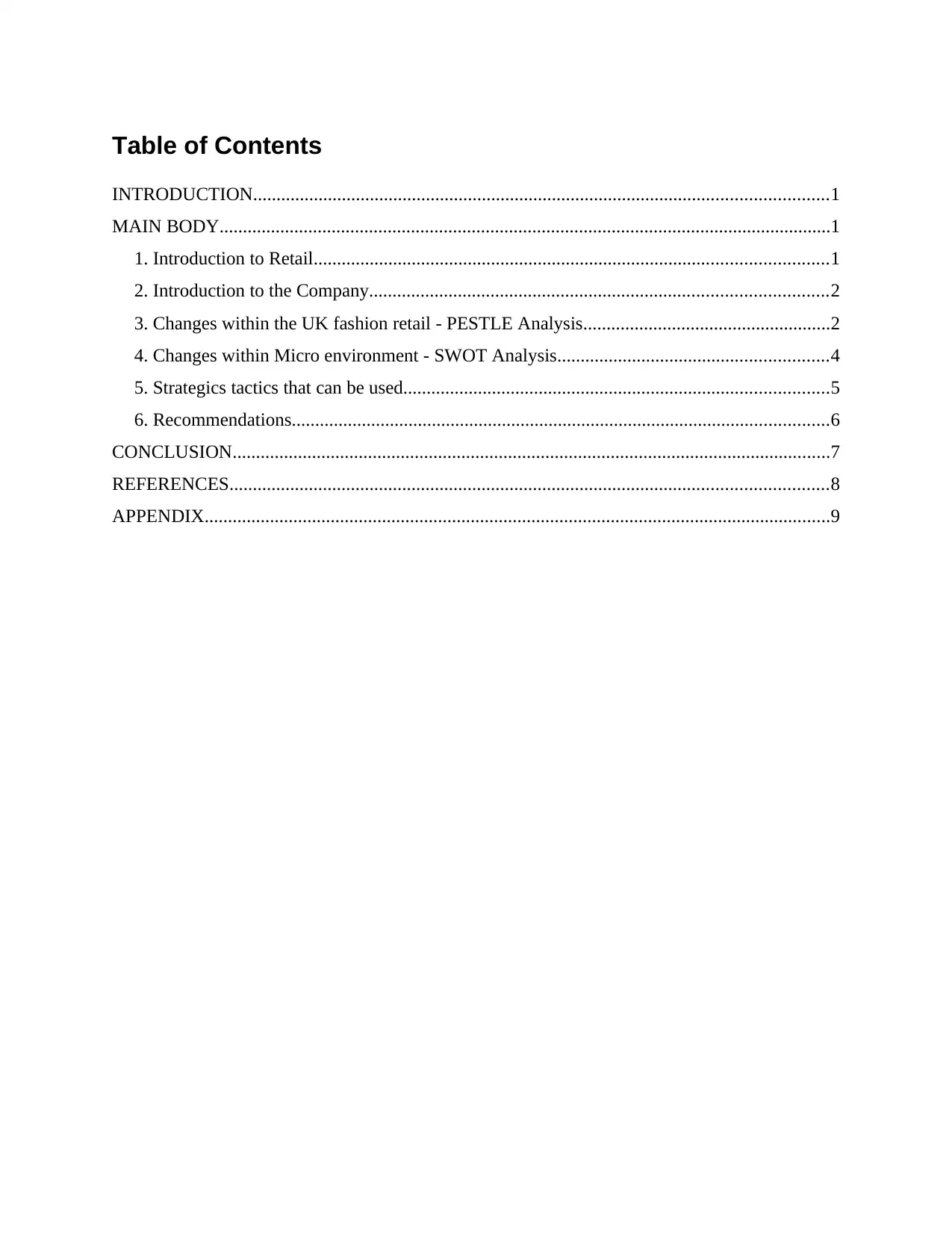
Table of Contents
INTRODUCTION...........................................................................................................................1
MAIN BODY...................................................................................................................................1
1. Introduction to Retail..............................................................................................................1
2. Introduction to the Company..................................................................................................2
3. Changes within the UK fashion retail - PESTLE Analysis.....................................................2
4. Changes within Micro environment - SWOT Analysis..........................................................4
5. Strategics tactics that can be used...........................................................................................5
6. Recommendations...................................................................................................................6
CONCLUSION................................................................................................................................7
REFERENCES................................................................................................................................8
APPENDIX......................................................................................................................................9
INTRODUCTION...........................................................................................................................1
MAIN BODY...................................................................................................................................1
1. Introduction to Retail..............................................................................................................1
2. Introduction to the Company..................................................................................................2
3. Changes within the UK fashion retail - PESTLE Analysis.....................................................2
4. Changes within Micro environment - SWOT Analysis..........................................................4
5. Strategics tactics that can be used...........................................................................................5
6. Recommendations...................................................................................................................6
CONCLUSION................................................................................................................................7
REFERENCES................................................................................................................................8
APPENDIX......................................................................................................................................9
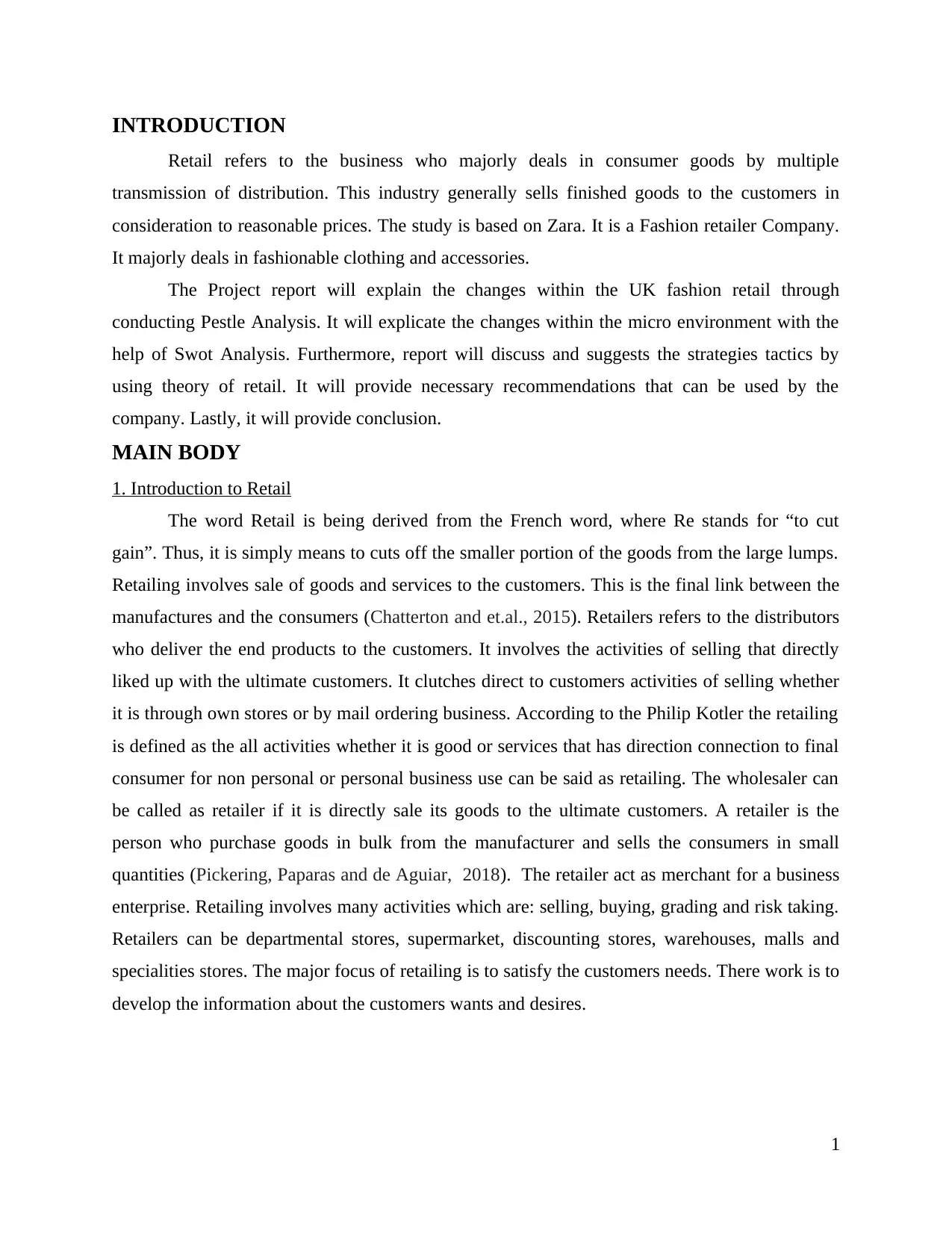
INTRODUCTION
Retail refers to the business who majorly deals in consumer goods by multiple
transmission of distribution. This industry generally sells finished goods to the customers in
consideration to reasonable prices. The study is based on Zara. It is a Fashion retailer Company.
It majorly deals in fashionable clothing and accessories.
The Project report will explain the changes within the UK fashion retail through
conducting Pestle Analysis. It will explicate the changes within the micro environment with the
help of Swot Analysis. Furthermore, report will discuss and suggests the strategies tactics by
using theory of retail. It will provide necessary recommendations that can be used by the
company. Lastly, it will provide conclusion.
MAIN BODY
1. Introduction to Retail
The word Retail is being derived from the French word, where Re stands for “to cut
gain”. Thus, it is simply means to cuts off the smaller portion of the goods from the large lumps.
Retailing involves sale of goods and services to the customers. This is the final link between the
manufactures and the consumers (Chatterton and et.al., 2015). Retailers refers to the distributors
who deliver the end products to the customers. It involves the activities of selling that directly
liked up with the ultimate customers. It clutches direct to customers activities of selling whether
it is through own stores or by mail ordering business. According to the Philip Kotler the retailing
is defined as the all activities whether it is good or services that has direction connection to final
consumer for non personal or personal business use can be said as retailing. The wholesaler can
be called as retailer if it is directly sale its goods to the ultimate customers. A retailer is the
person who purchase goods in bulk from the manufacturer and sells the consumers in small
quantities (Pickering, Paparas and de Aguiar, 2018). The retailer act as merchant for a business
enterprise. Retailing involves many activities which are: selling, buying, grading and risk taking.
Retailers can be departmental stores, supermarket, discounting stores, warehouses, malls and
specialities stores. The major focus of retailing is to satisfy the customers needs. There work is to
develop the information about the customers wants and desires.
1
Retail refers to the business who majorly deals in consumer goods by multiple
transmission of distribution. This industry generally sells finished goods to the customers in
consideration to reasonable prices. The study is based on Zara. It is a Fashion retailer Company.
It majorly deals in fashionable clothing and accessories.
The Project report will explain the changes within the UK fashion retail through
conducting Pestle Analysis. It will explicate the changes within the micro environment with the
help of Swot Analysis. Furthermore, report will discuss and suggests the strategies tactics by
using theory of retail. It will provide necessary recommendations that can be used by the
company. Lastly, it will provide conclusion.
MAIN BODY
1. Introduction to Retail
The word Retail is being derived from the French word, where Re stands for “to cut
gain”. Thus, it is simply means to cuts off the smaller portion of the goods from the large lumps.
Retailing involves sale of goods and services to the customers. This is the final link between the
manufactures and the consumers (Chatterton and et.al., 2015). Retailers refers to the distributors
who deliver the end products to the customers. It involves the activities of selling that directly
liked up with the ultimate customers. It clutches direct to customers activities of selling whether
it is through own stores or by mail ordering business. According to the Philip Kotler the retailing
is defined as the all activities whether it is good or services that has direction connection to final
consumer for non personal or personal business use can be said as retailing. The wholesaler can
be called as retailer if it is directly sale its goods to the ultimate customers. A retailer is the
person who purchase goods in bulk from the manufacturer and sells the consumers in small
quantities (Pickering, Paparas and de Aguiar, 2018). The retailer act as merchant for a business
enterprise. Retailing involves many activities which are: selling, buying, grading and risk taking.
Retailers can be departmental stores, supermarket, discounting stores, warehouses, malls and
specialities stores. The major focus of retailing is to satisfy the customers needs. There work is to
develop the information about the customers wants and desires.
1
⊘ This is a preview!⊘
Do you want full access?
Subscribe today to unlock all pages.

Trusted by 1+ million students worldwide
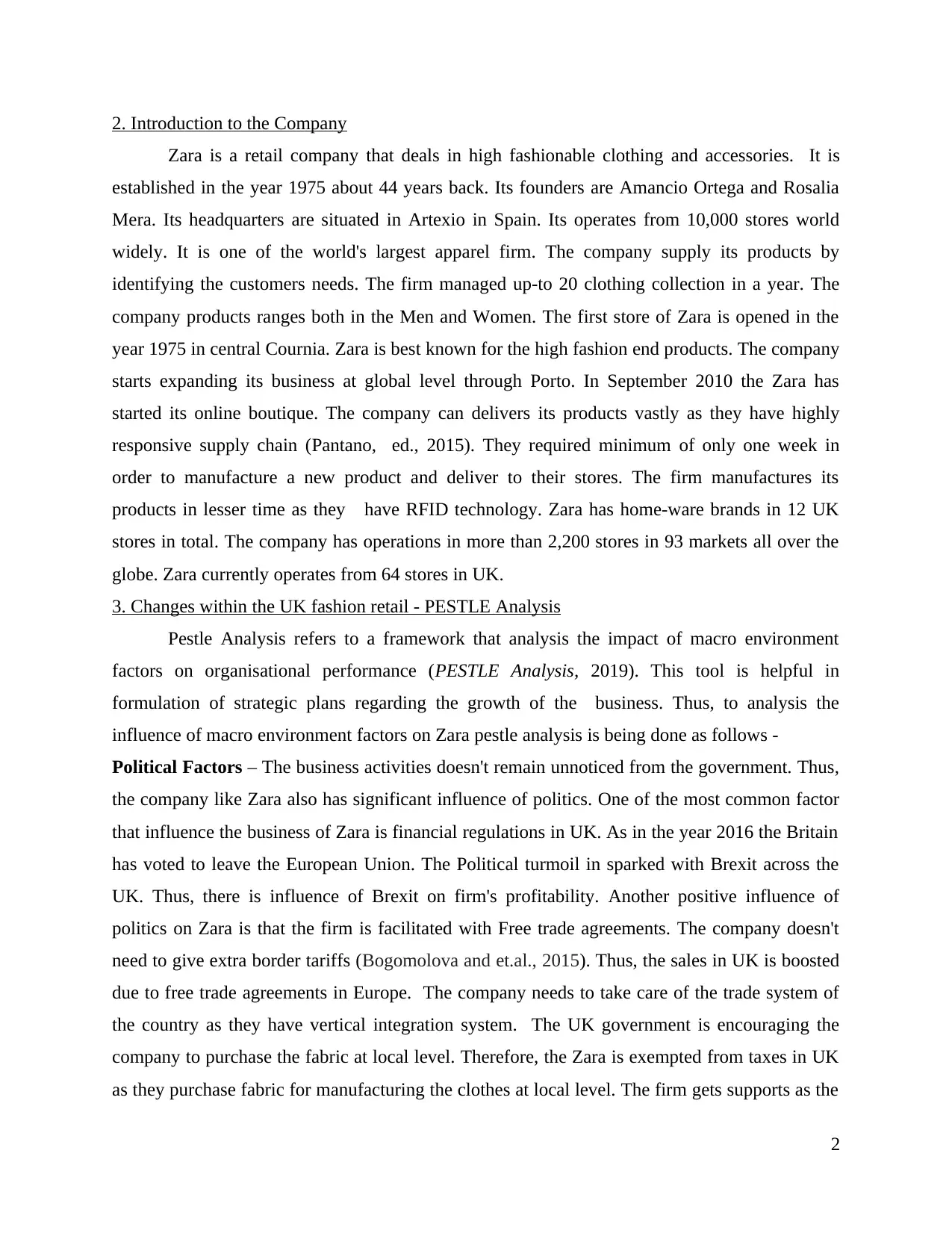
2. Introduction to the Company
Zara is a retail company that deals in high fashionable clothing and accessories. It is
established in the year 1975 about 44 years back. Its founders are Amancio Ortega and Rosalia
Mera. Its headquarters are situated in Artexio in Spain. Its operates from 10,000 stores world
widely. It is one of the world's largest apparel firm. The company supply its products by
identifying the customers needs. The firm managed up-to 20 clothing collection in a year. The
company products ranges both in the Men and Women. The first store of Zara is opened in the
year 1975 in central Cournia. Zara is best known for the high fashion end products. The company
starts expanding its business at global level through Porto. In September 2010 the Zara has
started its online boutique. The company can delivers its products vastly as they have highly
responsive supply chain (Pantano, ed., 2015). They required minimum of only one week in
order to manufacture a new product and deliver to their stores. The firm manufactures its
products in lesser time as they have RFID technology. Zara has home-ware brands in 12 UK
stores in total. The company has operations in more than 2,200 stores in 93 markets all over the
globe. Zara currently operates from 64 stores in UK.
3. Changes within the UK fashion retail - PESTLE Analysis
Pestle Analysis refers to a framework that analysis the impact of macro environment
factors on organisational performance (PESTLE Analysis, 2019). This tool is helpful in
formulation of strategic plans regarding the growth of the business. Thus, to analysis the
influence of macro environment factors on Zara pestle analysis is being done as follows -
Political Factors – The business activities doesn't remain unnoticed from the government. Thus,
the company like Zara also has significant influence of politics. One of the most common factor
that influence the business of Zara is financial regulations in UK. As in the year 2016 the Britain
has voted to leave the European Union. The Political turmoil in sparked with Brexit across the
UK. Thus, there is influence of Brexit on firm's profitability. Another positive influence of
politics on Zara is that the firm is facilitated with Free trade agreements. The company doesn't
need to give extra border tariffs (Bogomolova and et.al., 2015). Thus, the sales in UK is boosted
due to free trade agreements in Europe. The company needs to take care of the trade system of
the country as they have vertical integration system. The UK government is encouraging the
company to purchase the fabric at local level. Therefore, the Zara is exempted from taxes in UK
as they purchase fabric for manufacturing the clothes at local level. The firm gets supports as the
2
Zara is a retail company that deals in high fashionable clothing and accessories. It is
established in the year 1975 about 44 years back. Its founders are Amancio Ortega and Rosalia
Mera. Its headquarters are situated in Artexio in Spain. Its operates from 10,000 stores world
widely. It is one of the world's largest apparel firm. The company supply its products by
identifying the customers needs. The firm managed up-to 20 clothing collection in a year. The
company products ranges both in the Men and Women. The first store of Zara is opened in the
year 1975 in central Cournia. Zara is best known for the high fashion end products. The company
starts expanding its business at global level through Porto. In September 2010 the Zara has
started its online boutique. The company can delivers its products vastly as they have highly
responsive supply chain (Pantano, ed., 2015). They required minimum of only one week in
order to manufacture a new product and deliver to their stores. The firm manufactures its
products in lesser time as they have RFID technology. Zara has home-ware brands in 12 UK
stores in total. The company has operations in more than 2,200 stores in 93 markets all over the
globe. Zara currently operates from 64 stores in UK.
3. Changes within the UK fashion retail - PESTLE Analysis
Pestle Analysis refers to a framework that analysis the impact of macro environment
factors on organisational performance (PESTLE Analysis, 2019). This tool is helpful in
formulation of strategic plans regarding the growth of the business. Thus, to analysis the
influence of macro environment factors on Zara pestle analysis is being done as follows -
Political Factors – The business activities doesn't remain unnoticed from the government. Thus,
the company like Zara also has significant influence of politics. One of the most common factor
that influence the business of Zara is financial regulations in UK. As in the year 2016 the Britain
has voted to leave the European Union. The Political turmoil in sparked with Brexit across the
UK. Thus, there is influence of Brexit on firm's profitability. Another positive influence of
politics on Zara is that the firm is facilitated with Free trade agreements. The company doesn't
need to give extra border tariffs (Bogomolova and et.al., 2015). Thus, the sales in UK is boosted
due to free trade agreements in Europe. The company needs to take care of the trade system of
the country as they have vertical integration system. The UK government is encouraging the
company to purchase the fabric at local level. Therefore, the Zara is exempted from taxes in UK
as they purchase fabric for manufacturing the clothes at local level. The firm gets supports as the
2
Paraphrase This Document
Need a fresh take? Get an instant paraphrase of this document with our AI Paraphraser
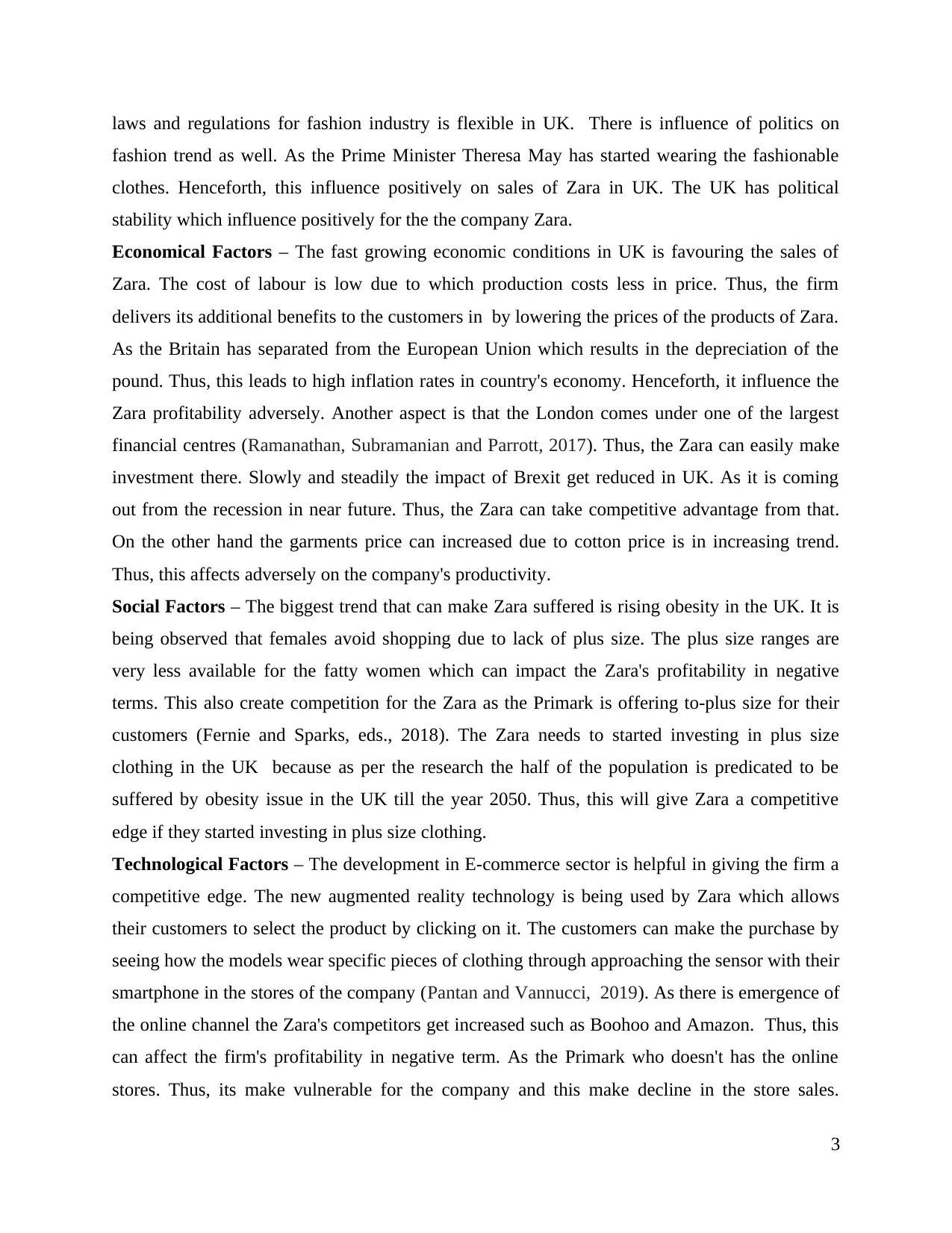
laws and regulations for fashion industry is flexible in UK. There is influence of politics on
fashion trend as well. As the Prime Minister Theresa May has started wearing the fashionable
clothes. Henceforth, this influence positively on sales of Zara in UK. The UK has political
stability which influence positively for the the company Zara.
Economical Factors – The fast growing economic conditions in UK is favouring the sales of
Zara. The cost of labour is low due to which production costs less in price. Thus, the firm
delivers its additional benefits to the customers in by lowering the prices of the products of Zara.
As the Britain has separated from the European Union which results in the depreciation of the
pound. Thus, this leads to high inflation rates in country's economy. Henceforth, it influence the
Zara profitability adversely. Another aspect is that the London comes under one of the largest
financial centres (Ramanathan, Subramanian and Parrott, 2017). Thus, the Zara can easily make
investment there. Slowly and steadily the impact of Brexit get reduced in UK. As it is coming
out from the recession in near future. Thus, the Zara can take competitive advantage from that.
On the other hand the garments price can increased due to cotton price is in increasing trend.
Thus, this affects adversely on the company's productivity.
Social Factors – The biggest trend that can make Zara suffered is rising obesity in the UK. It is
being observed that females avoid shopping due to lack of plus size. The plus size ranges are
very less available for the fatty women which can impact the Zara's profitability in negative
terms. This also create competition for the Zara as the Primark is offering to-plus size for their
customers (Fernie and Sparks, eds., 2018). The Zara needs to started investing in plus size
clothing in the UK because as per the research the half of the population is predicated to be
suffered by obesity issue in the UK till the year 2050. Thus, this will give Zara a competitive
edge if they started investing in plus size clothing.
Technological Factors – The development in E-commerce sector is helpful in giving the firm a
competitive edge. The new augmented reality technology is being used by Zara which allows
their customers to select the product by clicking on it. The customers can make the purchase by
seeing how the models wear specific pieces of clothing through approaching the sensor with their
smartphone in the stores of the company (Pantan and Vannucci, 2019). As there is emergence of
the online channel the Zara's competitors get increased such as Boohoo and Amazon. Thus, this
can affect the firm's profitability in negative term. As the Primark who doesn't has the online
stores. Thus, its make vulnerable for the company and this make decline in the store sales.
3
fashion trend as well. As the Prime Minister Theresa May has started wearing the fashionable
clothes. Henceforth, this influence positively on sales of Zara in UK. The UK has political
stability which influence positively for the the company Zara.
Economical Factors – The fast growing economic conditions in UK is favouring the sales of
Zara. The cost of labour is low due to which production costs less in price. Thus, the firm
delivers its additional benefits to the customers in by lowering the prices of the products of Zara.
As the Britain has separated from the European Union which results in the depreciation of the
pound. Thus, this leads to high inflation rates in country's economy. Henceforth, it influence the
Zara profitability adversely. Another aspect is that the London comes under one of the largest
financial centres (Ramanathan, Subramanian and Parrott, 2017). Thus, the Zara can easily make
investment there. Slowly and steadily the impact of Brexit get reduced in UK. As it is coming
out from the recession in near future. Thus, the Zara can take competitive advantage from that.
On the other hand the garments price can increased due to cotton price is in increasing trend.
Thus, this affects adversely on the company's productivity.
Social Factors – The biggest trend that can make Zara suffered is rising obesity in the UK. It is
being observed that females avoid shopping due to lack of plus size. The plus size ranges are
very less available for the fatty women which can impact the Zara's profitability in negative
terms. This also create competition for the Zara as the Primark is offering to-plus size for their
customers (Fernie and Sparks, eds., 2018). The Zara needs to started investing in plus size
clothing in the UK because as per the research the half of the population is predicated to be
suffered by obesity issue in the UK till the year 2050. Thus, this will give Zara a competitive
edge if they started investing in plus size clothing.
Technological Factors – The development in E-commerce sector is helpful in giving the firm a
competitive edge. The new augmented reality technology is being used by Zara which allows
their customers to select the product by clicking on it. The customers can make the purchase by
seeing how the models wear specific pieces of clothing through approaching the sensor with their
smartphone in the stores of the company (Pantan and Vannucci, 2019). As there is emergence of
the online channel the Zara's competitors get increased such as Boohoo and Amazon. Thus, this
can affect the firm's profitability in negative term. As the Primark who doesn't has the online
stores. Thus, its make vulnerable for the company and this make decline in the store sales.
3
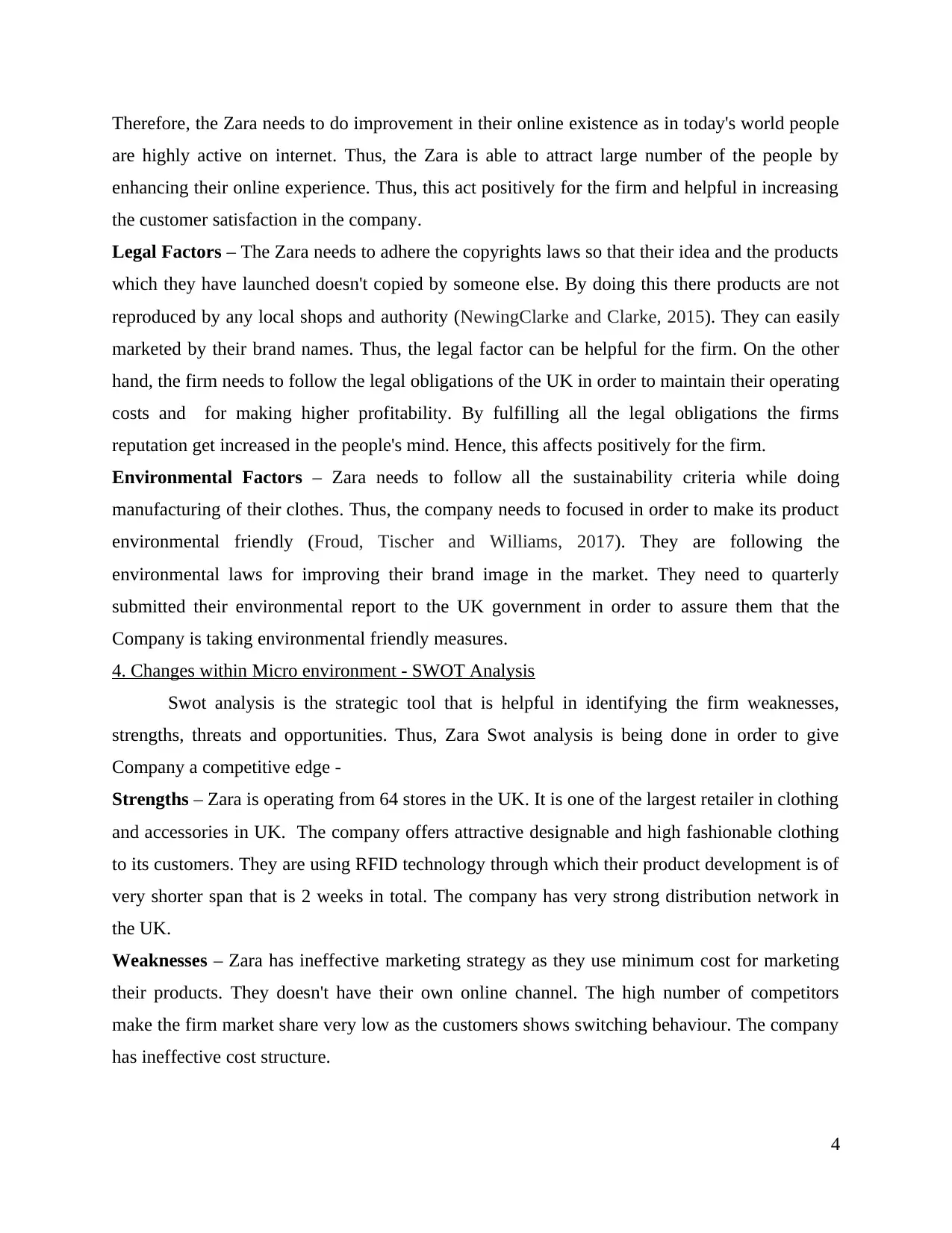
Therefore, the Zara needs to do improvement in their online existence as in today's world people
are highly active on internet. Thus, the Zara is able to attract large number of the people by
enhancing their online experience. Thus, this act positively for the firm and helpful in increasing
the customer satisfaction in the company.
Legal Factors – The Zara needs to adhere the copyrights laws so that their idea and the products
which they have launched doesn't copied by someone else. By doing this there products are not
reproduced by any local shops and authority (NewingClarke and Clarke, 2015). They can easily
marketed by their brand names. Thus, the legal factor can be helpful for the firm. On the other
hand, the firm needs to follow the legal obligations of the UK in order to maintain their operating
costs and for making higher profitability. By fulfilling all the legal obligations the firms
reputation get increased in the people's mind. Hence, this affects positively for the firm.
Environmental Factors – Zara needs to follow all the sustainability criteria while doing
manufacturing of their clothes. Thus, the company needs to focused in order to make its product
environmental friendly (Froud, Tischer and Williams, 2017). They are following the
environmental laws for improving their brand image in the market. They need to quarterly
submitted their environmental report to the UK government in order to assure them that the
Company is taking environmental friendly measures.
4. Changes within Micro environment - SWOT Analysis
Swot analysis is the strategic tool that is helpful in identifying the firm weaknesses,
strengths, threats and opportunities. Thus, Zara Swot analysis is being done in order to give
Company a competitive edge -
Strengths – Zara is operating from 64 stores in the UK. It is one of the largest retailer in clothing
and accessories in UK. The company offers attractive designable and high fashionable clothing
to its customers. They are using RFID technology through which their product development is of
very shorter span that is 2 weeks in total. The company has very strong distribution network in
the UK.
Weaknesses – Zara has ineffective marketing strategy as they use minimum cost for marketing
their products. They doesn't have their own online channel. The high number of competitors
make the firm market share very low as the customers shows switching behaviour. The company
has ineffective cost structure.
4
are highly active on internet. Thus, the Zara is able to attract large number of the people by
enhancing their online experience. Thus, this act positively for the firm and helpful in increasing
the customer satisfaction in the company.
Legal Factors – The Zara needs to adhere the copyrights laws so that their idea and the products
which they have launched doesn't copied by someone else. By doing this there products are not
reproduced by any local shops and authority (NewingClarke and Clarke, 2015). They can easily
marketed by their brand names. Thus, the legal factor can be helpful for the firm. On the other
hand, the firm needs to follow the legal obligations of the UK in order to maintain their operating
costs and for making higher profitability. By fulfilling all the legal obligations the firms
reputation get increased in the people's mind. Hence, this affects positively for the firm.
Environmental Factors – Zara needs to follow all the sustainability criteria while doing
manufacturing of their clothes. Thus, the company needs to focused in order to make its product
environmental friendly (Froud, Tischer and Williams, 2017). They are following the
environmental laws for improving their brand image in the market. They need to quarterly
submitted their environmental report to the UK government in order to assure them that the
Company is taking environmental friendly measures.
4. Changes within Micro environment - SWOT Analysis
Swot analysis is the strategic tool that is helpful in identifying the firm weaknesses,
strengths, threats and opportunities. Thus, Zara Swot analysis is being done in order to give
Company a competitive edge -
Strengths – Zara is operating from 64 stores in the UK. It is one of the largest retailer in clothing
and accessories in UK. The company offers attractive designable and high fashionable clothing
to its customers. They are using RFID technology through which their product development is of
very shorter span that is 2 weeks in total. The company has very strong distribution network in
the UK.
Weaknesses – Zara has ineffective marketing strategy as they use minimum cost for marketing
their products. They doesn't have their own online channel. The high number of competitors
make the firm market share very low as the customers shows switching behaviour. The company
has ineffective cost structure.
4
⊘ This is a preview!⊘
Do you want full access?
Subscribe today to unlock all pages.

Trusted by 1+ million students worldwide
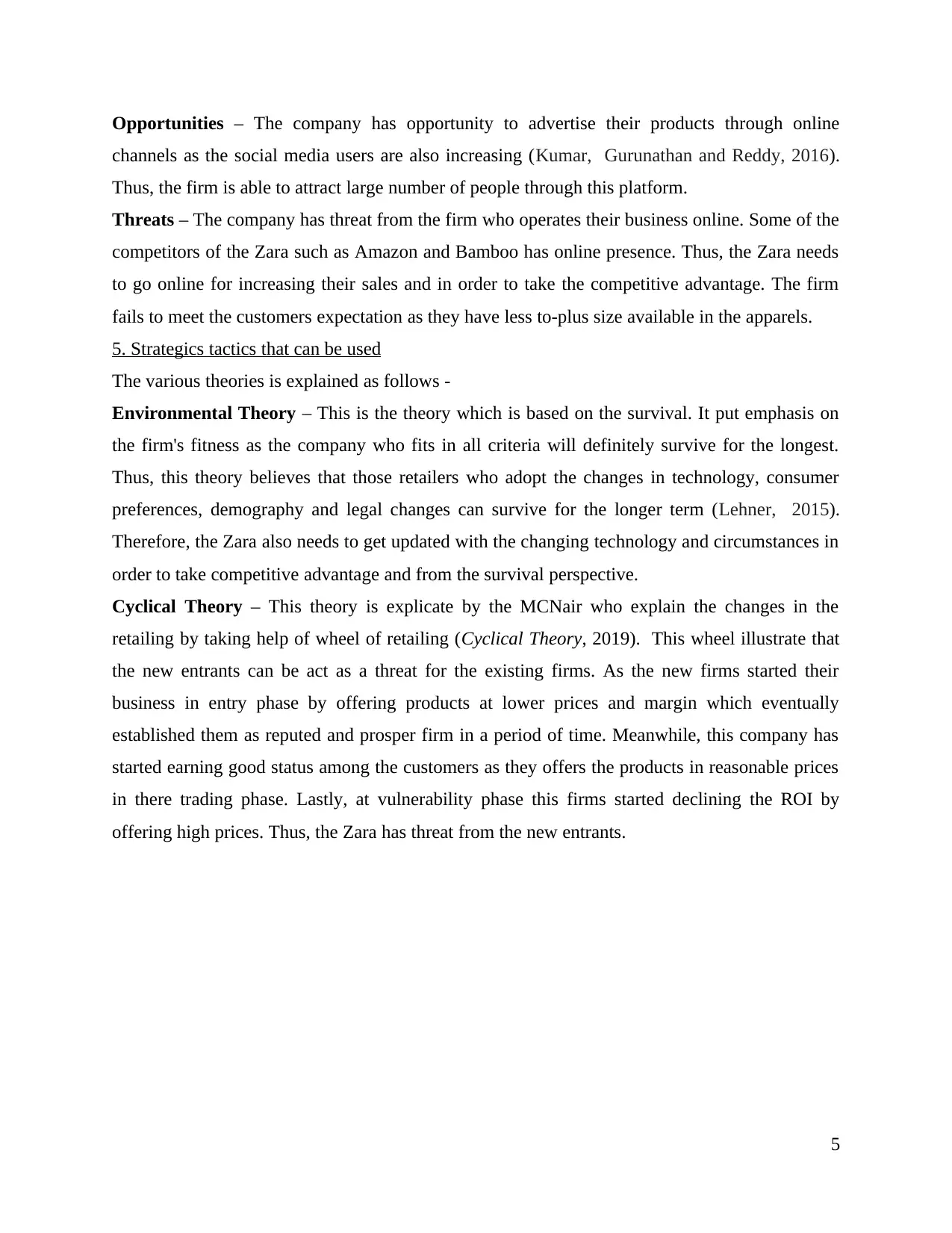
Opportunities – The company has opportunity to advertise their products through online
channels as the social media users are also increasing (Kumar, Gurunathan and Reddy, 2016).
Thus, the firm is able to attract large number of people through this platform.
Threats – The company has threat from the firm who operates their business online. Some of the
competitors of the Zara such as Amazon and Bamboo has online presence. Thus, the Zara needs
to go online for increasing their sales and in order to take the competitive advantage. The firm
fails to meet the customers expectation as they have less to-plus size available in the apparels.
5. Strategics tactics that can be used
The various theories is explained as follows -
Environmental Theory – This is the theory which is based on the survival. It put emphasis on
the firm's fitness as the company who fits in all criteria will definitely survive for the longest.
Thus, this theory believes that those retailers who adopt the changes in technology, consumer
preferences, demography and legal changes can survive for the longer term (Lehner, 2015).
Therefore, the Zara also needs to get updated with the changing technology and circumstances in
order to take competitive advantage and from the survival perspective.
Cyclical Theory – This theory is explicate by the MCNair who explain the changes in the
retailing by taking help of wheel of retailing (Cyclical Theory, 2019). This wheel illustrate that
the new entrants can be act as a threat for the existing firms. As the new firms started their
business in entry phase by offering products at lower prices and margin which eventually
established them as reputed and prosper firm in a period of time. Meanwhile, this company has
started earning good status among the customers as they offers the products in reasonable prices
in there trading phase. Lastly, at vulnerability phase this firms started declining the ROI by
offering high prices. Thus, the Zara has threat from the new entrants.
5
channels as the social media users are also increasing (Kumar, Gurunathan and Reddy, 2016).
Thus, the firm is able to attract large number of people through this platform.
Threats – The company has threat from the firm who operates their business online. Some of the
competitors of the Zara such as Amazon and Bamboo has online presence. Thus, the Zara needs
to go online for increasing their sales and in order to take the competitive advantage. The firm
fails to meet the customers expectation as they have less to-plus size available in the apparels.
5. Strategics tactics that can be used
The various theories is explained as follows -
Environmental Theory – This is the theory which is based on the survival. It put emphasis on
the firm's fitness as the company who fits in all criteria will definitely survive for the longest.
Thus, this theory believes that those retailers who adopt the changes in technology, consumer
preferences, demography and legal changes can survive for the longer term (Lehner, 2015).
Therefore, the Zara also needs to get updated with the changing technology and circumstances in
order to take competitive advantage and from the survival perspective.
Cyclical Theory – This theory is explicate by the MCNair who explain the changes in the
retailing by taking help of wheel of retailing (Cyclical Theory, 2019). This wheel illustrate that
the new entrants can be act as a threat for the existing firms. As the new firms started their
business in entry phase by offering products at lower prices and margin which eventually
established them as reputed and prosper firm in a period of time. Meanwhile, this company has
started earning good status among the customers as they offers the products in reasonable prices
in there trading phase. Lastly, at vulnerability phase this firms started declining the ROI by
offering high prices. Thus, the Zara has threat from the new entrants.
5
Paraphrase This Document
Need a fresh take? Get an instant paraphrase of this document with our AI Paraphraser
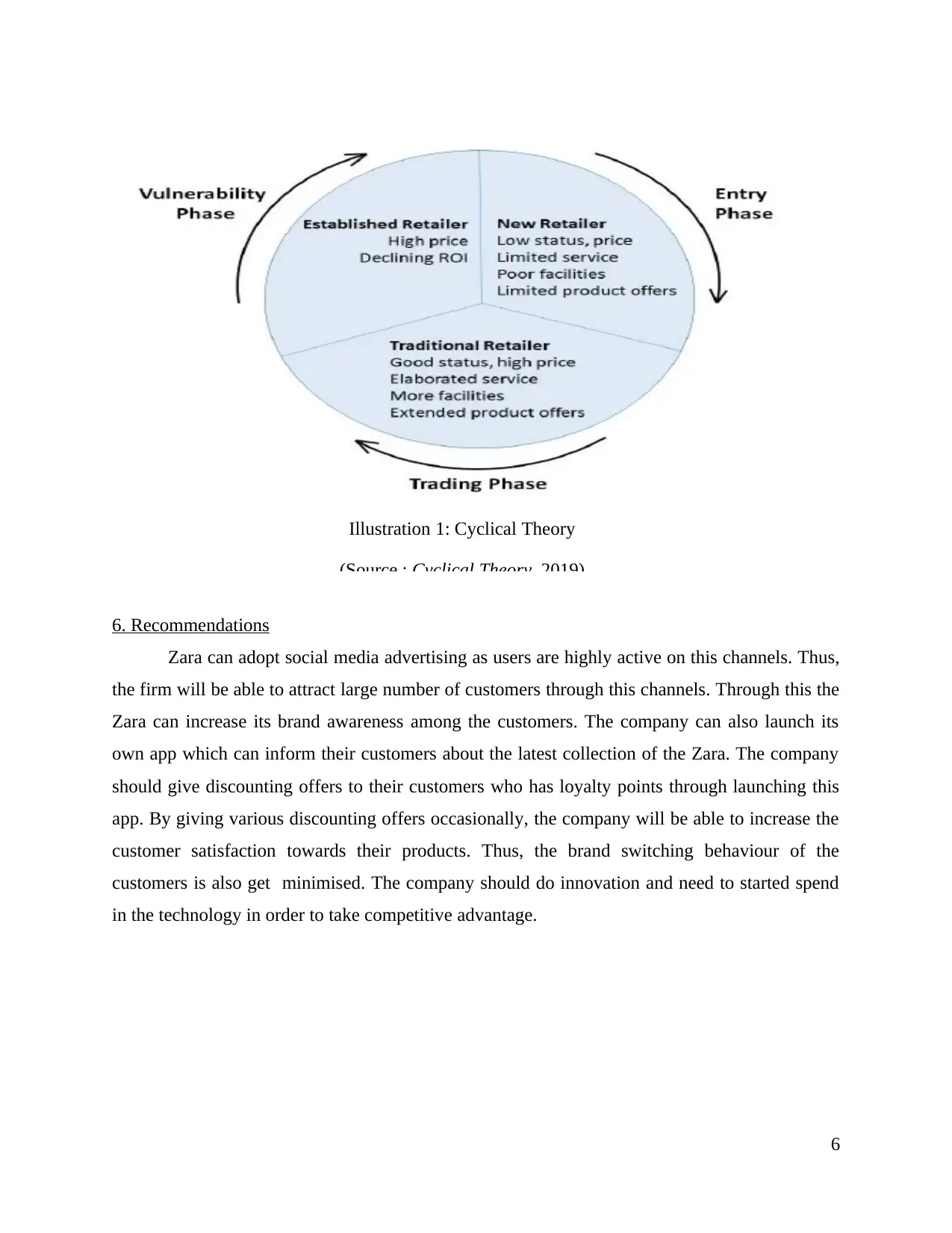
Illustration 1: Cyclical Theory
(Source : Cyclical Theory, 2019)
6. Recommendations
Zara can adopt social media advertising as users are highly active on this channels. Thus,
the firm will be able to attract large number of customers through this channels. Through this the
Zara can increase its brand awareness among the customers. The company can also launch its
own app which can inform their customers about the latest collection of the Zara. The company
should give discounting offers to their customers who has loyalty points through launching this
app. By giving various discounting offers occasionally, the company will be able to increase the
customer satisfaction towards their products. Thus, the brand switching behaviour of the
customers is also get minimised. The company should do innovation and need to started spend
in the technology in order to take competitive advantage.
6
(Source : Cyclical Theory, 2019)
6. Recommendations
Zara can adopt social media advertising as users are highly active on this channels. Thus,
the firm will be able to attract large number of customers through this channels. Through this the
Zara can increase its brand awareness among the customers. The company can also launch its
own app which can inform their customers about the latest collection of the Zara. The company
should give discounting offers to their customers who has loyalty points through launching this
app. By giving various discounting offers occasionally, the company will be able to increase the
customer satisfaction towards their products. Thus, the brand switching behaviour of the
customers is also get minimised. The company should do innovation and need to started spend
in the technology in order to take competitive advantage.
6
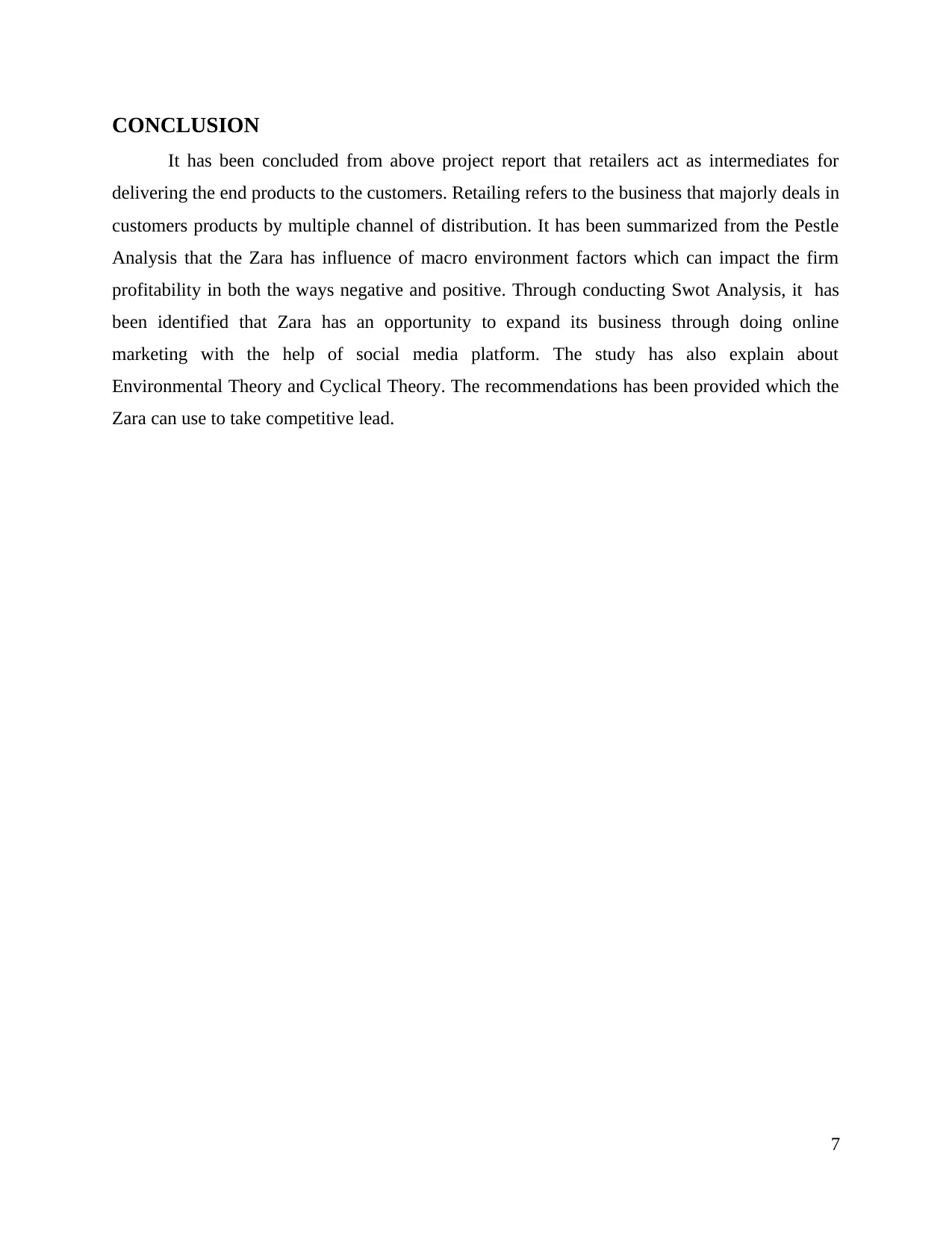
CONCLUSION
It has been concluded from above project report that retailers act as intermediates for
delivering the end products to the customers. Retailing refers to the business that majorly deals in
customers products by multiple channel of distribution. It has been summarized from the Pestle
Analysis that the Zara has influence of macro environment factors which can impact the firm
profitability in both the ways negative and positive. Through conducting Swot Analysis, it has
been identified that Zara has an opportunity to expand its business through doing online
marketing with the help of social media platform. The study has also explain about
Environmental Theory and Cyclical Theory. The recommendations has been provided which the
Zara can use to take competitive lead.
7
It has been concluded from above project report that retailers act as intermediates for
delivering the end products to the customers. Retailing refers to the business that majorly deals in
customers products by multiple channel of distribution. It has been summarized from the Pestle
Analysis that the Zara has influence of macro environment factors which can impact the firm
profitability in both the ways negative and positive. Through conducting Swot Analysis, it has
been identified that Zara has an opportunity to expand its business through doing online
marketing with the help of social media platform. The study has also explain about
Environmental Theory and Cyclical Theory. The recommendations has been provided which the
Zara can use to take competitive lead.
7
⊘ This is a preview!⊘
Do you want full access?
Subscribe today to unlock all pages.

Trusted by 1+ million students worldwide
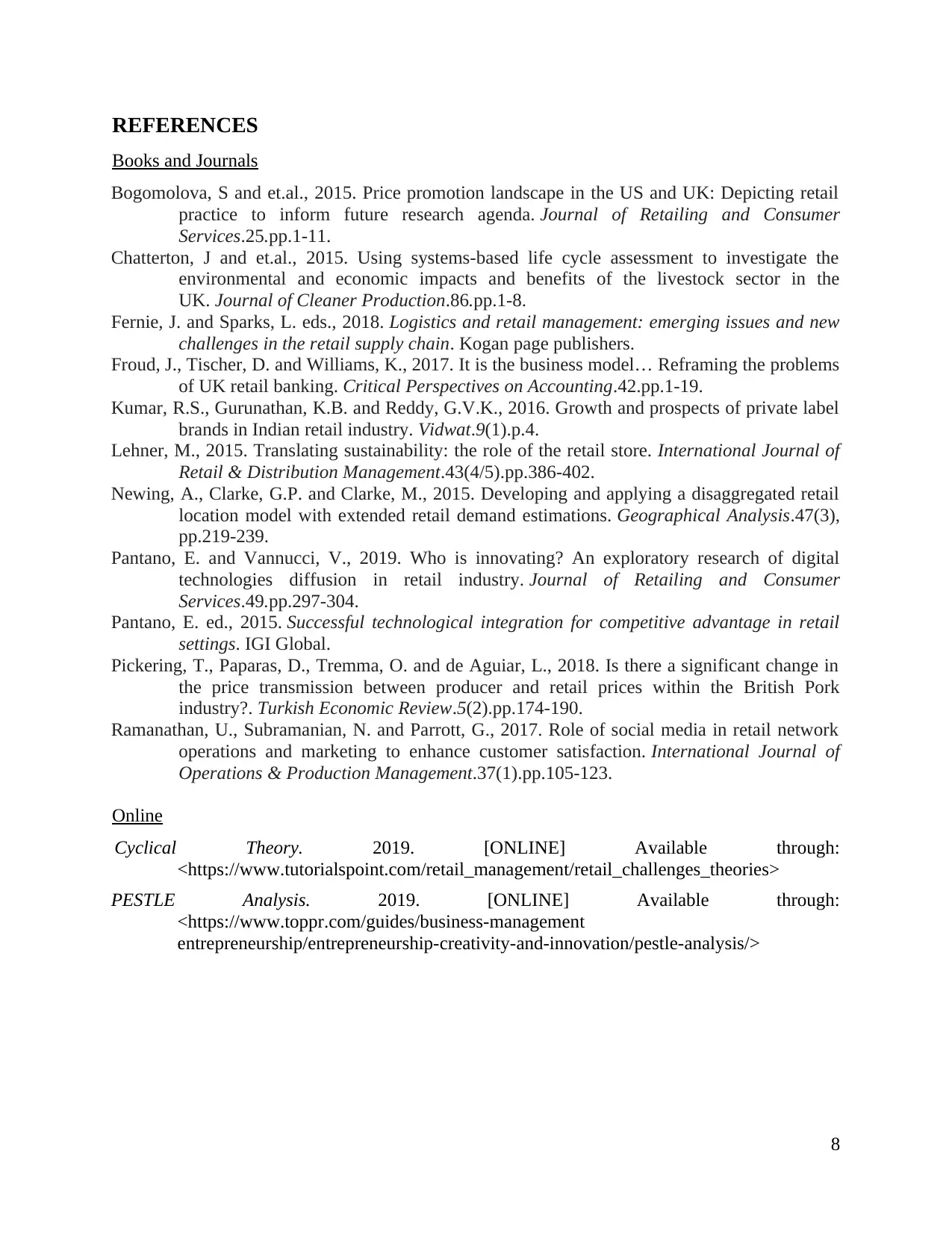
REFERENCES
Books and Journals
Bogomolova, S and et.al., 2015. Price promotion landscape in the US and UK: Depicting retail
practice to inform future research agenda. Journal of Retailing and Consumer
Services.25.pp.1-11.
Chatterton, J and et.al., 2015. Using systems-based life cycle assessment to investigate the
environmental and economic impacts and benefits of the livestock sector in the
UK. Journal of Cleaner Production.86.pp.1-8.
Fernie, J. and Sparks, L. eds., 2018. Logistics and retail management: emerging issues and new
challenges in the retail supply chain. Kogan page publishers.
Froud, J., Tischer, D. and Williams, K., 2017. It is the business model… Reframing the problems
of UK retail banking. Critical Perspectives on Accounting.42.pp.1-19.
Kumar, R.S., Gurunathan, K.B. and Reddy, G.V.K., 2016. Growth and prospects of private label
brands in Indian retail industry. Vidwat.9(1).p.4.
Lehner, M., 2015. Translating sustainability: the role of the retail store. International Journal of
Retail & Distribution Management.43(4/5).pp.386-402.
Newing, A., Clarke, G.P. and Clarke, M., 2015. Developing and applying a disaggregated retail
location model with extended retail demand estimations. Geographical Analysis.47(3),
pp.219-239.
Pantano, E. and Vannucci, V., 2019. Who is innovating? An exploratory research of digital
technologies diffusion in retail industry. Journal of Retailing and Consumer
Services.49.pp.297-304.
Pantano, E. ed., 2015. Successful technological integration for competitive advantage in retail
settings. IGI Global.
Pickering, T., Paparas, D., Tremma, O. and de Aguiar, L., 2018. Is there a significant change in
the price transmission between producer and retail prices within the British Pork
industry?. Turkish Economic Review.5(2).pp.174-190.
Ramanathan, U., Subramanian, N. and Parrott, G., 2017. Role of social media in retail network
operations and marketing to enhance customer satisfaction. International Journal of
Operations & Production Management.37(1).pp.105-123.
Online
Cyclical Theory. 2019. [ONLINE] Available through:
<https://www.tutorialspoint.com/retail_management/retail_challenges_theories>
PESTLE Analysis. 2019. [ONLINE] Available through:
<https://www.toppr.com/guides/business-management
entrepreneurship/entrepreneurship-creativity-and-innovation/pestle-analysis/>
8
Books and Journals
Bogomolova, S and et.al., 2015. Price promotion landscape in the US and UK: Depicting retail
practice to inform future research agenda. Journal of Retailing and Consumer
Services.25.pp.1-11.
Chatterton, J and et.al., 2015. Using systems-based life cycle assessment to investigate the
environmental and economic impacts and benefits of the livestock sector in the
UK. Journal of Cleaner Production.86.pp.1-8.
Fernie, J. and Sparks, L. eds., 2018. Logistics and retail management: emerging issues and new
challenges in the retail supply chain. Kogan page publishers.
Froud, J., Tischer, D. and Williams, K., 2017. It is the business model… Reframing the problems
of UK retail banking. Critical Perspectives on Accounting.42.pp.1-19.
Kumar, R.S., Gurunathan, K.B. and Reddy, G.V.K., 2016. Growth and prospects of private label
brands in Indian retail industry. Vidwat.9(1).p.4.
Lehner, M., 2015. Translating sustainability: the role of the retail store. International Journal of
Retail & Distribution Management.43(4/5).pp.386-402.
Newing, A., Clarke, G.P. and Clarke, M., 2015. Developing and applying a disaggregated retail
location model with extended retail demand estimations. Geographical Analysis.47(3),
pp.219-239.
Pantano, E. and Vannucci, V., 2019. Who is innovating? An exploratory research of digital
technologies diffusion in retail industry. Journal of Retailing and Consumer
Services.49.pp.297-304.
Pantano, E. ed., 2015. Successful technological integration for competitive advantage in retail
settings. IGI Global.
Pickering, T., Paparas, D., Tremma, O. and de Aguiar, L., 2018. Is there a significant change in
the price transmission between producer and retail prices within the British Pork
industry?. Turkish Economic Review.5(2).pp.174-190.
Ramanathan, U., Subramanian, N. and Parrott, G., 2017. Role of social media in retail network
operations and marketing to enhance customer satisfaction. International Journal of
Operations & Production Management.37(1).pp.105-123.
Online
Cyclical Theory. 2019. [ONLINE] Available through:
<https://www.tutorialspoint.com/retail_management/retail_challenges_theories>
PESTLE Analysis. 2019. [ONLINE] Available through:
<https://www.toppr.com/guides/business-management
entrepreneurship/entrepreneurship-creativity-and-innovation/pestle-analysis/>
8
Paraphrase This Document
Need a fresh take? Get an instant paraphrase of this document with our AI Paraphraser
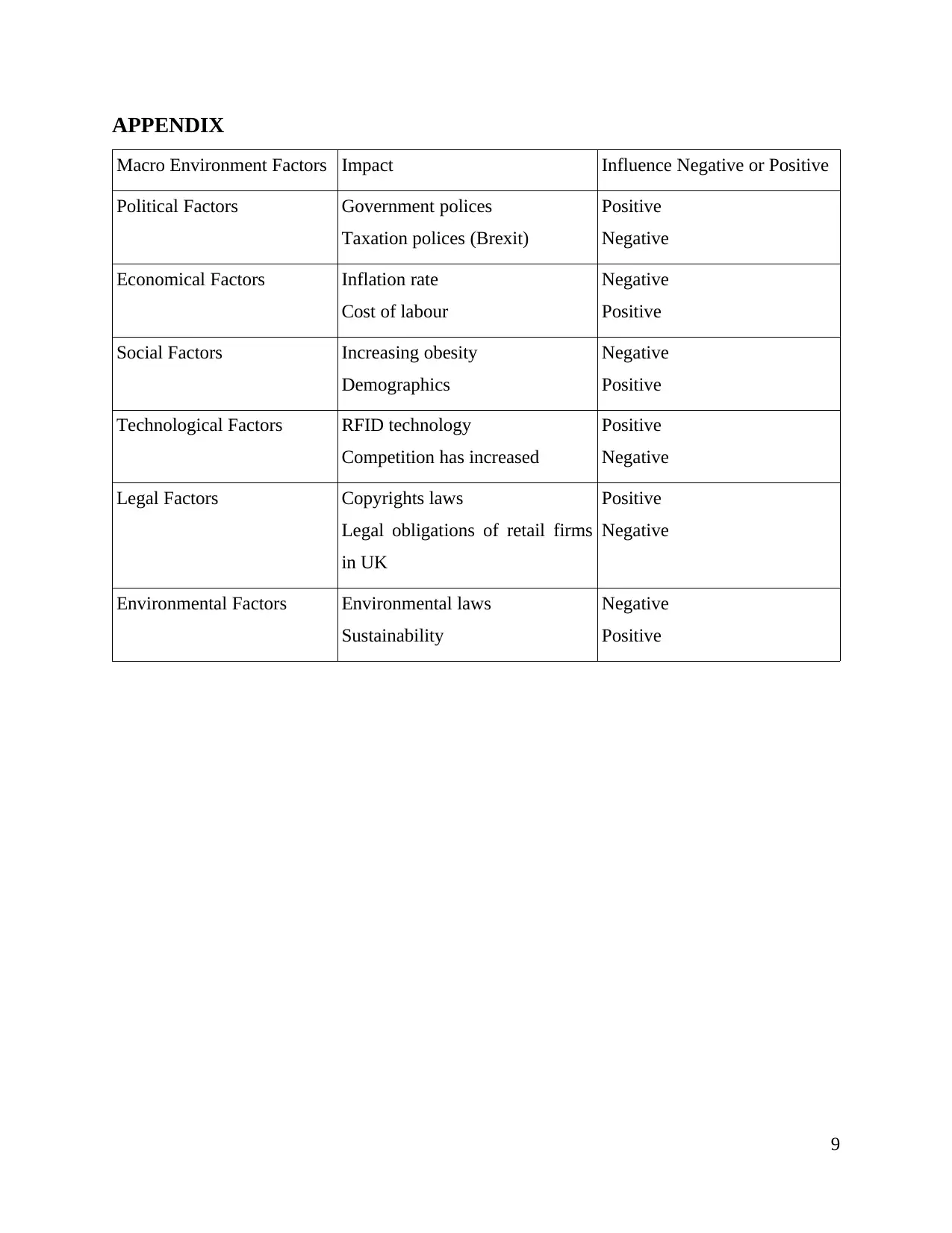
APPENDIX
Macro Environment Factors Impact Influence Negative or Positive
Political Factors Government polices
Taxation polices (Brexit)
Positive
Negative
Economical Factors Inflation rate
Cost of labour
Negative
Positive
Social Factors Increasing obesity
Demographics
Negative
Positive
Technological Factors RFID technology
Competition has increased
Positive
Negative
Legal Factors Copyrights laws
Legal obligations of retail firms
in UK
Positive
Negative
Environmental Factors Environmental laws
Sustainability
Negative
Positive
9
Macro Environment Factors Impact Influence Negative or Positive
Political Factors Government polices
Taxation polices (Brexit)
Positive
Negative
Economical Factors Inflation rate
Cost of labour
Negative
Positive
Social Factors Increasing obesity
Demographics
Negative
Positive
Technological Factors RFID technology
Competition has increased
Positive
Negative
Legal Factors Copyrights laws
Legal obligations of retail firms
in UK
Positive
Negative
Environmental Factors Environmental laws
Sustainability
Negative
Positive
9
1 out of 11
Related Documents
Your All-in-One AI-Powered Toolkit for Academic Success.
+13062052269
info@desklib.com
Available 24*7 on WhatsApp / Email
![[object Object]](/_next/static/media/star-bottom.7253800d.svg)
Unlock your academic potential
Copyright © 2020–2025 A2Z Services. All Rights Reserved. Developed and managed by ZUCOL.





